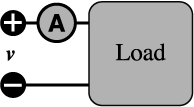What
is the Unit of Current?
The unit of current is
coulomb per second (C/s), which is the same
as ampere (A). The
ampere is one of the SI units and as such,
it is not a derived unit of measure. The
ampere is attributed to the French physicist
ANDRÉ-MARIE
AMPÈRE who lived in
the 1700s and early 1800s. A current must
flow through a finite area (a conducting
wire of a finite cross section, for example).
A current of one ampere
flows when one coulomb of charge passes
a point in a circuit in one second. Remember
that one coulomb is equal to the motion
of the charge of 6.28 × 1018electrons
within an interval of one second. We use
an ammeter to measure current.
Figure 2.2 shows a symbol of ammeter in
an electric circuit.

Figure 2.2 Measuring
current flow.
Types of Current
There are different
types of current as illustrated in Figure
2.3.
-
A current that is constant in time
is termed a direct current (DC)
as shown in Figure 2.3(a).
-
Direct current refers
to current that is flowing in a wire
continuously in one direction at a specified
value.
Another type of
current that varies sinusoidaly with time
is shown in Figure 2.3(b).
-
This type of current is referred to
as alternating current
(AC) and exists in household circuits.
-
This current is bi-directional, which
means that it goes back and forth, reversing
its direction at regular intervals.
-
The number of times the direction
changes (and changes back) per second
is called the frequency
(f),
and is expressed by the number of cycles
per second, a unit called Hertz (Hz).
|